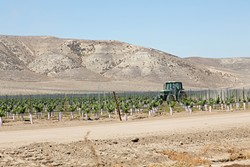[{
"name": "Ad - Medium Rectangle CC01 - 300x250",
"id": "AdMediumRectangleCC01300x250",
"class": "inlineCenter",
"insertPoint": "8",
"component": "2963441",
"requiredCountToDisplay": "12"
},{
"name": "Ad - Medium Rectangle LC01 - 300x250",
"id": "AdMediumRectangleCC01300x250",
"class": "inlineCenter",
"insertPoint": "18",
"component": "2963441",
"requiredCountToDisplay": "22"
},{
"name": "Ad - Medium Rectangle LC09 - 300x250",
"id": "AdMediumRectangleLC09300x250",
"class": "inlineCenter",
"insertPoint": "28",
"component": "3252660",
"requiredCountToDisplay": "32"
}]
Things may be very, very dry in this county. Nonetheless, the five members of the San Luis Obispo Board of Supervisors recently managed to find enough wet earth for some scrappy mud wrestling.
The most recent bout was all but inevitable as the five-member board revisited an item that involves the Nipomo Mesa, the Paso Robles Groundwater Basin, and regulating water use, all at the same time.
That item, the countywide water conservation program, was approved 3-2 after a long round of haggling at the board’s Oct. 27 meeting.
The countywide water conservation program, or the CWWCP, sets out to create mechanisms to curb expanded water use in severely stressed water basins, while setting general water conservation rules throughout the unincorporated parts of the county.
The program was designed to permanently replace the Paso Robles Groundwater Basin urgency ordinance, which passed in 2013, and expired this year. That ordinance was passed amid outcry from rural residents whose wells were running dry, and concerns that continued vineyard expansion would further intensify the problem.
The CWWCP limits new wells and new building permits for groundwater basins that are classified as being in extreme drought. Currently, that includes the Paso Robles Groundwater Basin and the Nipomo Mesa Water Conservation Area. The Los Osos Groundwater Basin is also at an extreme drought level, but there are already policies in place for it.
The program also requires that in certain areas any new irrigated agriculture or building permits offset their water use through a program that includes crop conversion, plumbing fixture changes, and other water conservation practices. Countywide, it sets new policies for water use in the incorporated area, limiting the hours of lawn and landscape irrigation, how water can be used in decorative water fountains or to wash cars, and commercial and industrial uses.
On July 21, the board decided in a heated 3-2 split to the give the Planning Commission more time to pick through and vet the ordinance.
After several hearings on the matter, the commission returned the item back to the board with a series of recommendations. The Board of Supervisors generally approved those recommendations after discussing several points of the program at length at the Oct. 27 meeting.
The offset program was a key issue for the supervisors. A 1:1 offset requirement was initially proposed for Paso and Nipomo, but 2nd District Supervisor Bruce Gibson and 3rd District Supervisor Adam Hill wanted the board to consider a 2:1 offset, where all new water use would only be permitted if twice as much water was conserved. That offset, they argued, would help slow decline in water levels in the two basins.
First District Supervisor Frank Mecham, 4th District Supervisor Lynn Compton, and 5th District Supervisor Debbie Arnold disagreed. In fact, both Compton and Arnold had issues with the offset requirement altogether.
Compton expressed a fundamental issue with the offset requirements, using an example of a longtime property owner who has just now gotten around to drawing up plans to build on the land.
“You would basically have to buy your neighbor his plumbing fixtures, and get his plumbing fixtures in his house, before you could build on your property which has been there for 100 years,” Compton said.
In the end, the 1:1 offset was approved by the board for the program.
Other questions raised about the program included whether it was constitutionally legal, and if the looming El Niño rains would alleviate the water supply concerns.
At the end of the day, after sharp verbal exchanges between the supervisors, Mecham joined Hill and Gibson to approve the program.
“The idea of waiting, that’s what got us into this,” Mecham said. “I just can’t see the point of trying to wait.”
-- Melody DeMeritt - former city council member, Morro Bay
Latest in News
Readers also liked…
-

Coast Unified teachers upset over new position's salary and qualifications
Oct 20, 2022 -

SLO police identify alleged driver who hit and killed couple
Dec 22, 2022 -

When the levee breaks: Oceano residents, county officials walk a tightrope of regulations to manage Arroyo Grande Creek, which some say led to the levee's failure in January
May 18, 2023







